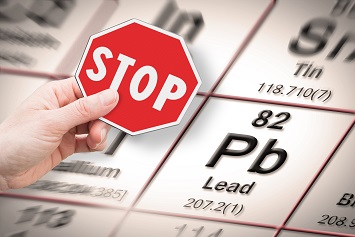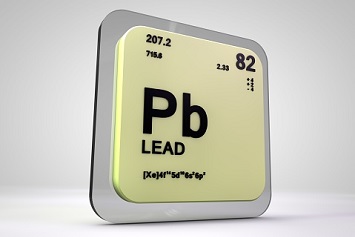Worker safety advocates, scientists, and some state OSHA authorities have been contending for years that OSHA’s permissible exposure levels (PELs) for lead in the workplace are inadequate to protect workers from the multiple adverse health effects associated with the metal.
OSHA established its standard for lead in general industry in 1978. Construction workers were not covered until 1993 when OSHA set a separate standard for construction. The PEL in both standards remains unchanged since promulgation—50 micrograms of lead per cubic meter of air (µg/m3), averaged over an 8-hour workday. This limit was set so that workers’ blood lead levels (BLLs) would not exceed 40 µg per deciliter of blood (µg/dL), a level once found by OSHA to adequately protect workers from adverse health effects.
OSHA has acknowledged that scientific evidence indicates that the lead PEL is many times more than the minimum level needed to protect worker health. But, officially, the agency has appeared less concerned about the level of protection afforded than whether the PEL is imposing undue financial hardship on employers. For example, in 2007, OSHA conducted a Regulatory Flexibility Act review of the lead-in-construction standard and concluded that the standard remained necessary to protect the workers from lead poisoning, but that measures could be taken to simplify the requirements for small businesses and better integrate the standard with lead requirements of the EPA and the Department of Housing and Urban Development. The review did not address whether the 50-ug/m3 PEL was sufficiently protective of worker health (September 27, 2007, Federal Register (FR)).
PELs and BLLs
One important reservation about the lead PEL was expressed in a December 2012 report by the National Research Council (NRC), which was asked by the Department of Defense to evaluate whether the OSHA standards adequately protect the military’s firing range employees, who are exposed to lead recurrently when they handle ammunition, conduct maintenance on ranges, and inhale lead dust released into the air by gunfire. Citing evaluations performed by the U.S. National Toxicology Program and the EPA, the NRC said there was “compelling evidence that nervous system, kidney, heart, reproductive and other health problems can be caused by blood lead levels between 10 and 40 µg/dL or even lower levels.”
“Because of the association between air concentrations and blood levels, the [NRC] committee also concluded that the 50 µg/m3 OSHA limit for lead in air is inadequate for protecting workers; a lower level is clearly warranted,” the NRC concluded.
The California Department of Public Health (CDPH) is one state agency that has been particularly concerned about the adequacy of the lead PEL for workers. Cal/OSHA’s PELs for both general industry and construction are identical to OSHA. But, in a September 2013 letter, the CDPH informed Cal/OSHA that it had determined that having chronic BLLs in the range of 5 to 10 µg/dL poses a health risk to working adults. According to the CDPH, to bring BLLs below the 5- to 10-µg/dL range, a PEL for lead not exceeding 0.5 to 2.1 µg/m3 would need to be established and met by employers.
OSHA’s Unofficial Position
OSHA does not dispute findings that its lead PELs are inadequate by a large margin. An undated statement on OSHA’s website contains the following:
“Recent studies have provided evidence that lead can cause health effects at blood lead levels lower than those established by OSHA’s 1978 lead standard. Epidemiological and experimental studies indicate that chronic exposure resulting in blood lead levels (BLL) as low as 10 µg/dL in adults are associated with impaired kidney function, high blood pressure, nervous system and neurobehavioral effects, cognitive dysfunction later in life, and subtle cognitive effects attributed to prenatal exposure. Pregnant women need to be especially concerned with reducing BLL since this can have serious impact on the developing fetus.
“Chronic exposures leading to BLLs above 20 µg/dL can cause subclinical effects on cognitive functions as well as adverse effects on sperm/semen quality and delayed conception. BLLs between 20 to 40 µg/dL are associated with effects such as cognitive aging as well as deficits in visuomotor dexterity, lower reaction times, and attention deficit. At BBLs above 40 µg/dL, workers begin to experience symptoms such as headache, fatigue, sleep disturbance, joint pain, myalgia, anorexia, and constipation….
“OSHA’s general industry and construction lead standards include a medical removal protection provision for workers whose blood lead levels reach or exceed 50 µg/dL (construction) or 60 µg/dL (general industry). Recently, medical management guidelines for adult lead exposure have been developed by a national expert panel coordinated by the Association of Occupational and Environmental Clinics (AOEC), in collaboration with the NIOSH [National Institute for Occupational Safety and Health] Adult Blood Lead Epidemiology and Surveillance (ABLES) program. The panel recommends that maintaining BLLs below 20 µg/dL over a twenty-year period, or below 10 µg/dL over a forty-year period, would be sufficient to prevent chronic effects associated with cumulative exposures.”
OSHA’s Standards
The main elements of OSHA’s lead standards for general industry (29 CFR 1910.1025) and construction (29 CFR 1910.1025) are as follows:
- A PEL of 50 µg/m3 averaged over an 8-hour period.
- An action level (AL) of 30 µg/m3 averaged over an 8-hour period and regardless of use of respirators. The AL is the level at which an employer must begin specific compliance activities (e.g., monitoring representative of the exposure for each employee in the workplace who is exposed to lead).
- Requirements that employers use engineering controls and work practices, where feasible, to reduce worker exposure.
- Requirements that employees observe good personal hygiene practices, such as washing hands before eating and taking a shower before leaving the worksite.
- Requirements that employees be provided with protective clothing and, where necessary, with respiratory protection in accordance with 29 CFR 1910.134.
- A requirement that employees exposed to high levels of lead be enrolled in a medical surveillance program.
Reducing Workplace Lead Hazards
Regardless of the level of worker protection from lead exposure required by federal and state agencies, employers can take actions to lower the PEL to levels recommended by occupational health experts. These practices can be applied wherever workers are exposed to lead.
Identification of lead hazards and employee training
- Safety data sheets and labels are reviewed for all raw materials or products used to determine if they contain lead.
- If work involves disturbing paint or surface coatings on metal structures or pre-1978 buildings, coatings are tested for lead (or are assumed to contain lead), and all necessary precautions are taken.
- All employees potentially exposed to lead dust or fumes are trained in the hazards of lead, how to protect themselves, and the worker protections required by the applicable federal or state lead standard.
Assessment of lead hazards
- Personal air monitoring is conducted to determine the 8-hour average airborne exposure to lead for all employees potentially exposed to lead dust or fumes.
- Air monitoring is repeated with any change in process, control, personnel, or tasks.
- When exposures are above the AL but below the PEL, air monitoring is repeated at least every 6 months.
- When exposures are above the PEL, air monitoring is repeated quarterly.
Medical program
- A lead-specific medical program is in place and under the supervision of a licensed physician knowledgeable about all relevant federal or state requirements.
- Blood lead and zinc protoporphyrin (ZPP) testing are done at least every 6 months for employees exposed to lead and more frequently for employees with higher BLLs. A more frequent monitoring schedule is recommended for construction workers exposed to lead, e.g., at the start and finish of each major job, and at least every 2 months in between.
- Medical exams specific to the potential health effects of lead are provided initially and repeated as determined by the physician or the requirements of the federal or state standard.
- Blood lead and ZPP results are provided in writing to employees within 5 days of receiving them from the laboratory.
- Employees with BLLs at or greater than 50 µg/dL are removed from further exposure to lead and provided with alternate work or full pay and benefits, at least until 2 consecutive monthly blood lead levels are below 40 µg/dL.
Wash-up facilities, personal hygiene, and protective clothing
- No eating, drinking, using tobacco products, or applying cosmetics occur in work areas where lead may be present.
- Clean protective clothing (disposable or regularly laundered) and shoes or shoe coverings are provided regularly to employees. They are not taken home from the jobsite.
- Wash-up facilities with warm water, soap, and clean towels are available and consistently used by workers to clean up before breaks and at the end of the shift.
- Showers are available and used daily by workers exposed to high levels of lead.
- Workers change their clothes in a clean change room/area with separate storage facilities for work and street clothing and shoes.
- There is a clean area, separated from the work area, for workers to take breaks and eat lunch.
Exposure controls
- Lead-free materials are substituted and high exposure tasks are eliminated where possible.
- Airborne lead levels over 50 µg/m3 are reduced by engineering controls (e.g., local exhaust ventilation) or changing work practices before relying on respirators or administrative controls.
- The work area is kept as free as possible from lead contamination, through regular cleaning by safe methods (e.g., wet mopping or vacuuming with a toxic dust high-efficiency particulate air (HEPA) vacuum); dry sweeping is not done.
- There is a written compliance program for reducing exposures over 50 µg/m3.
Respirators
- Respirators are used to protect against airborne lead exposure if needed.
- Respirators are selected based on measured airborne lead exposure levels and the assigned protection factor (APF) of the respirator. In construction, respirators are selected initially based on the task being performed, its assumed exposure level, and the APF of the respirator.
- A complete respirator program is in place where respirators are used and includes annual face seal fit testing, regular face seal checking, training, medical determination of fitness for respirator wearing, and provisions for cleaning and storage.


